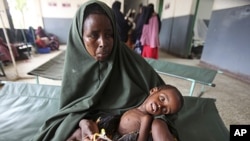As a prolonged, severe drought puts 10 million people at risk in East Africa, humanitarian agencies are hard-pressed to supply enough food and water. Crops have been destroyed, farmland damaged, seeds consumed as food and livestock sold so families can survive. Thousands of people have migrated to neighboring countries hoping to find relief. They often just find more of the same.
The U.N. Environment Program (UNEP) has issued warnings for years on the affects of potential climate change, deforestation and the loss of grasslands and wetlands.
“This is not a new phenomenon. I mean we seem to be seeing the increasing frequency over recent years these kinds of events,” said Nick Nuttall, chief spokesman for UNEP, which is based Nairobi.
While droughts are not definitive proof of climate change, Nuttall said, “It certainly is part of environmental change, which is happening in the Horn of Africa, but also happening across Africa in terms of land quality…availability of fresh water, in terms of more frequent drought and floods.”
The term “climate change” is often used to refer to the effects of human activity, whereas “environmental change” is used to indicate natural ecological processes.
As emergency relief operations continue to feed the hungry and malnourished, scientists are trying to determine what’s causing the problems.
“The best scientists in the world have analyzed what has been going on in recent decades and they’re using the best available scientific models to try and work out what might happen in the future,” he said.
Going to extremes
“Africa is already a climate-extreme continent. You already have extremes of rainfall and of drought naturally. The fact we’re actually seeing changes in that pattern…more frequency in terms of droughts and floods …begs the question, is it climate change?”
Temperatures have risen on the continent. Nuttall said, “Africa has warmed by about 0.7 degrees centigrade during the 20th Century. And some of the highest temperatures were certainly recorded during the end of the 1990s. And you are seeing changes in rainfall. There’s been a 25 percent decrease in rainfall over the Sahel region, for example, during the past 30 years. In some of the tropical rainforest regions of Africa, since about the mid-1970s you’ve seen rainfall falling by something like 2.4 percent per decade,” he said.
While East Africa has been plagued by drought, other parts of the continent are actually getting more rain. “If you’ve got more heat in the atmosphere, you get more evaporation of water from the sea,” he said.
However, he added, “If you look at the situation in terms of the devastation of croplands and pasturelands, about 65 percent of Africa’s croplands are now degraded. About 30 percent of the pasturelands are in the same condition, which is also adding to problems with crop yields, problems with food security.”
He said it’s important to look at all the environmental changes now occurring and consider what might happen if they continue for another decade, “unless we can actually start delivering some kind of sustainable development in this part of the world.”
Lessons from the past
In Africa’s past, the Sahara was green. Historians have said an early Egyptian culture apparently collapsed as a result of drastic changes in the environment and weather. But is it climate change or a natural progression of environmental changes?
“Whether we’re seeing a natural progression or not, these were events that happened in the past due to natural cycles. The difference in the period of time we’re seeing right now is that the greenhouse gas emissions that are being pumped out mainly by the industrial world, but increasingly by the rapidly developing world, are actually forcing natural trends into a different trajectory,” said the UNEP spokesman.
While it may be different from the past, Nuttall said, “The past gives us clues as to how this thing might evolve.”
Forests
For many years, the UNEP has spoken out against deforestation and its effects on the environment.
“One of the critical, critical issues in terms of actually adapting to climate change and also indeed in terms of reducing emissions will be how the world manages its forests,” he said.
Kenya, for example, is working to restore the Mau Complex, which Nuttall calls the “largest closed canopy forest in Africa.”
“In the last couple of years, the government of Kenya, with support from other governments, has now started reinvesting in the rehabilitation of this forest system. And the question you have to ask is why? This one forest is actually worth several billions of dollars every year in terms of the services it provides,” he said.
That includes the water flow affecting more than a dozen major river systems needed for drinking water, hydroelectric power, tourism and the tea industry.
“So suddenly you’re seeing a whole dynamic in terms of a relationship with the forest,” he said.






